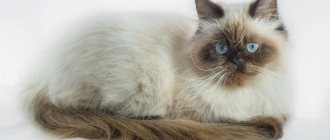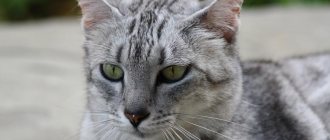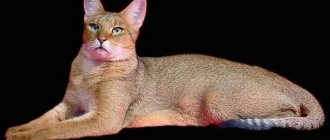History of the origin of the breed
Representatives of this breed received their mysterious name due to the similarity of color with the Himalayan rabbit. Himalayan cats were first bred in Great Britain in the mid-20th century. However, the USA is recognized as the country of origin.
The progenitors of this species are cats of two breeds: Siamese and Persian. However, the Persian clearly predominates in the Himalayan breed. It is curious that because of the Siamese color, Himalayan cats are also called color-point cats. Translated from English, “color point” means “colored dot” - an unusual color of Siamese cats. It should be noted that this coloration is also found in other representatives of the breeds.
Care and care
Long-haired Persian Colorpoints are extremely demanding in care. Cats need to be bathed frequently and thoroughly brushed. They take water procedures calmly, and some even love them. The cat should be washed with a special shampoo, and under no circumstances with soap. Then you simply won’t comb their luxurious fur. Sometimes cats start to darken. For young pets, this can be a serious disadvantage at shows.
Cats can darken for genetic reasons and due to individual physiology. If a cat lives in a warm place, its coat is lighter. The temperature should be at least 20, but not more than 30 degrees Celsius. In extreme heat, your cat may begin to shed. Try to prevent your pet from spending a lot of time in the cold, or looking around on the balcony.
What is a color point color?
Other cats received this unusual color from Siamese cats, which had it by nature. In America, this color is called “Himalayan” because it was studied on the Himalayan breed of rabbits. As a result of a mutation in the gene (color), which is responsible for color, different intensities of the cat’s body color arose. Thus, the darkest color is observed in remote areas of the body: on the muzzle, ears, paws and tail, and the rest of the body, where the temperature is higher, almost no pigment is formed. However, it does not disappear completely, but lightens so much that it appears white. “Points” are accumulations of pigment on distant parts of a pet’s body. But the color of cats, with intensely colored markings on the body, is called color point.
Initially, it all started with the fact that breeders deliberately began breeding a new breed of cats. The Himalayan cat was supposed to combine the amazing color of the noble Siamese breed and the length of the coat and temperament of the Persian cat breed. However, such achievements were not achieved immediately. The difficulties in breeding Himalayan cats boiled down to the fact that the kittens were born not only Perso-Siamese, but also Siamese-Persians. The latter species had predominant Siamese roots. That is why these kittens no longer took part in further breeding.
For the first time, breeders tried to breed a Persian black cat with a Siamese cat. However, all kittens were born black and short-haired. A Siamese cat and a black Persian cat were then taken to obtain the desired result. Black short-haired kittens were born. However, among them there was one cat. With the subsequent crossing of kittens from these 2 litters, it was finally possible to achieve the desired result and the first Siamese-Persian cat was born, which received the name Debutante.
Health
The health status of the Persian and exotic shorthair breeds has a feature associated with the structure of the muzzle. A wide and short nose does not allow the inhaled air to quickly warm up, for this reason the animal can quickly catch a cold in drafts or prolonged stay in a cold room. Large, wide eyes are often prone to watery eyes, so regular hygiene is necessary. Persians and exotics sometimes suffer from gum inflammation - gingivitis. Preventive examinations and timely diagnosis will solve this problem. Otherwise, they are strong, healthy animals with a good immune system.
Genetic diseases of the Persian and exotic shorthair breeds:
- Retinal atrophy is a progressive disease characterized by the gradual destruction of the visual cells of the retina, leading to blindness. Animals with such a hereditary predisposition are not allowed for breeding.
- Polycystic kidney disease (PKD) is an inherited disease in which multiple cavities (cysts) form in the kidneys, leading to kidney failure and death of the animal. There is a PKD test to assess predisposition to this disease. Animals at risk are not allowed for breeding.
- Hypertrophic cardiomyopathy is a disease characterized by enlargement of the heart muscle, which leads to the development of heart failure. Timely diagnosis and treatment will allow you to control the disease.
Features and character of the Himalayan cat
It should be noted that all color points are very friendly and calm. Himalayan cats love to communicate with people and get great pleasure from it. In many ways, the character of Himalayan cats depends on the conditions in which the cat grew up, as well as on how often it was interacted with. In fact, Himalayan cats form incredibly strong bonds with people and always reciprocate kind treatment.
Himalayan cats are very well-mannered and clean. You can take them with you on long trips. After all, they are completely calm about changing the situation. However, they must always be sure that the owner will not leave them and will always be there.
Attachment to family
Unlike Siamese cats, which have an unbalanced character, color-point cats are reasonable, sociable and calm. They love to be the center of attention and do their best to attract it. They are demanding of their owners and will not forgive a neglectful attitude towards themselves. Both a small kitten and an adult cat do not like to be left alone for a long time. Although, if you make sure that your pet has enough toys, a scratching post house with shelves, she is quite capable of staying in the apartment alone. Do not look at the fact that cats of this breed look clumsy in appearance. They love to run and play for a long time. This is important if you have children. They can have a great time together. They are not silent like Persian cats, but they are not as talkative as Siamese cats. If you are not the owner of a country mansion with an area where your pet can walk, then your cat will do just fine with walks on the balcony.
But one thing is important. These cats require one thing from their owners - attention. Giving your affection and affection in return. She can lie on your lap for long hours, purring with pleasure, and she will not care about your current affairs at all. The main thing is that she is happy, and her owner loves her.
Acquisition and maintenance costs
Himalayan kittens cost approximately the same as Persian cats. However, the cost of kittens varies and depends on the coat color, gender and age of the kitten, as well as on the level of the cattery. The price of Himalayan cat kittens starts at 10 thousand rubles.
When keeping a Himalayan cat, special attention should be paid to caring for the pet's fur. Some representatives of this breed have special glands that secrete a lot of fatty lubricant. Therefore, if the fur begins to shine or an unpleasant odor appears, then the pet must be washed. If you neglect hygiene conditions and do not comb your pet, tangles may occur. The fur will certainly begin to tangle, stick together, and form a sticky, thick mass in which dirt and insects can accumulate. In this case, some pieces of wool will have to be cut off. It is not difficult to guess that such extreme measures are unlikely to improve the appearance of the Himalayan cat. Therefore, you need to comb your Himalayan cat regularly, using a wide-tooth comb.
By the way, Himalayan cats love to swim. Of course, this fact will make caring for your pet easier. In addition to the fur, you need to take care of the eyes and face of the Himalayan cat. After all, Himalayan cats often experience increased lacrimation.
How to choose the right kitten
To avoid being deceived, it is advisable to buy a Himalayan kitten from trusted breeders or certified nurseries. Before concluding a transaction, you must make sure that you have a veterinary passport with vaccination marks and documents confirming your breed.
It is also advisable to pay attention to the behavior and living conditions of small Himalayans. Kittens should be inquisitive and playful. And the room where the Himalayans live should be warm, light and clean.
It is important that kittens do not have fleas, bald spots, scratching, unpleasant odor from the mouth and dirt under the tail. Healthy Himalayans should have a soft coat and clean eyes and ears.
Kitten care
Himalayan kittens from good nurseries go to new homes no earlier than they are 12 weeks old. By this point, they are already eating a variety of foods on their own, know how to use a litter box, and are accustomed to a scratching post. Therefore, the owners only need to wait until the little Himalayan gets comfortable in the new place and show him where he can eat and relieve himself.
Owners must take care of the kitten's safety in advance. To ensure that the Himalayan does not suffer from his own curiosity, large equipment and windows are covered from him, and household chemicals, small items, indoor plants and wires are also hidden.
To prevent the kitten from developing digestive problems amid the stress associated with the move, at first it is fed what it is accustomed to. New foods are introduced into the little Himalayan’s diet gradually to monitor the body’s reaction. The feeding schedule is based on the age of the kitten:
- up to 12 weeks – 5-6 times a day;
- 3-6 months – 4 times a day;
- 6-12 months – 3 times a day.
An adult Himalayan cat is switched to twice feeding.
Feeding a Himalayan cat
Experts recommend feeding Himalayan cats high-quality wet or dry food. For example, premium or super premium class.
It is better not to give natural food at all, or to carefully plan the diet. In this case, it is necessary to add vitamins and minerals. It must be remembered that the diet should not include many foods, including fatty, salty, fried, spicy and sweet foods. In addition, Himalayan cats are prone to obesity. In this regard, it is necessary to control the cat’s feeding process.
Colors
The colors of the Persian cat are very diverse and are divided into varieties. Among them:
- Tinted.
- Plain.
- Ticked.
- Chinchilla.
- Bicolor.
- Haze.
These are tabby, agouti, solid, color point, as well as various color shades from black to white. By the way, 20% of white Persian cats with blue eyes are born deaf. But Persians' eyes are mostly copper in tone and also green.
Mating and breeding
To get healthy offspring, it is necessary to take a responsible approach to the issue of breeding Persian cats. Basic Rules:
- Readiness. The female is usually ready for mating at the third heat (about a year), but if the timing is not pressing, it is advisable to wait until 1.5 - 2 years. This will give you a better chance of getting healthy kittens.
- Correct selection of the male. The cat must be completely healthy. It is advisable to familiarize yourself with his pedigree and veterinary passport to make sure that he does not have genetic diseases.
- Preparation. Both partners must be properly prepared. They should be given an anthelmintic a month before mating, and vaccinated 2 weeks before. The cat's nails need to be trimmed to prevent injury to the cat.
The cat is brought to the cat's territory, where mating will take place. This usually takes 2 days. Together with the cat you need to bring all its dowry: a house, bowls, a tray. This way she will feel freer and more comfortable.
Usually the cat does not let the cat get close at first; it can take several hours to get used to him and the new environment. Its readiness is indicated by its characteristic position: it bends down, lies on its front paws and raises its tail. Upon completion of the process, the cat may become aggressive and even attack the male, but this quickly passes. If mating is successful, the expectant mother will be happy to roll on the floor on her back.
Persian cats and female cats have romantic relationships when they sleep together, eat, lick each other and show their affection in other ways.
Pregnancy in a Persian cat lasts for 2 months (63–65 days). Most often it occurs without complications. However, the expectant mother needs to be provided with adequate, balanced nutrition and safety, because she becomes clumsy and may fall from a high shelf or cabinet.
By the end of the third week you can see a small round belly. In another week, the cat’s nipples will swell and become brighter. A week before giving birth, when milk begins to arrive, they will increase in size even more.
The owner needs to prepare a secluded place for the pet where she will give birth. It could even be a cardboard box with soft, clean bedding placed at the bottom. This house needs to be made in advance so that the cat understands what it is for and takes a liking to it.
During childbirth, it is better not to disturb the cat, but if it is too attached to its owner, then it is possible and even necessary to be present nearby. There are situations when a cat will need emergency help from the owner or even a veterinarian, so you shouldn’t completely forget about it. During contractions, you need to talk kindly to the cat, stroking her back, if she allows. This will help her give birth faster.
Childbirth usually lasts about a day. During this time, 3–6 kittens are born. If labor is prolonged and the cat cannot give birth, then you need to urgently call a veterinarian, otherwise death is possible. However, this happens extremely rarely.
The character and habits of the Persians
The character of the Persian cat is quite docile, if not calm. The cares of a neutered Persian cat include activities such as eating, daytime and nighttime sleep, as well as short periods when the pet is busy playing. Moreover, the Persian will not simply chase a jingling ball around the house. He needs ribbons, mice and games with his owner.
Persians are quite loving. But these are not the cats that will happily climb onto their owner’s lap and purr tirelessly. True Persians really do not like to sit on their hands; they approach a person only when they themselves need affection and attention.
You can safely leave Persians at home alone, but for a short time. The pet will sleep and rarely go out to eat. But if the owners decide to leave home for a long time, they will have to compensate for the gap in love and affection with increased courtship of the Persian.
Pros and cons of the breed
| pros | Minuses |
|
|
Persian diet
This breed is quite capricious in terms of digestion. Therefore, the Persian diet should consist of professional food. Dry type and pates are acceptable. It is strictly not recommended to mix them.
It is rare to give treats “from the table”. This is raw meat, cheese, cottage cheese, sour cream. Under no circumstances should you feed your Persian cat raw fish. Phosphates can clog the ureters, and the animal will die from intoxication.











